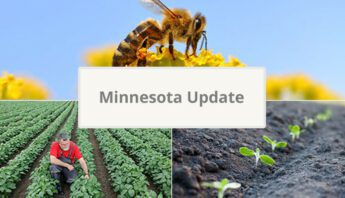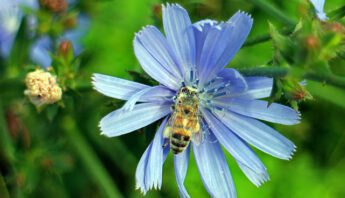This is the time of year when our thoughts turn toward reflection, gratitude and celebration…and food. As I share meals with loved ones, I’m also celebrating the real progress we made for a safe and equitable food system in 2015.
Sometimes in this work, concrete wins are few and far between. But this year is different. This year, our work contributed to meaningful victories for farmers, farmworkers, children and honey bees — thanks to powerful collaborations, smart campaigns and the tenacity of the PAN community.
Sweet news for bees
So many of us were talking about the link between honey bee die-offs and neonicotinoids last year that the Obama administration was moved to launch a federal inter-agency task force to address the problem. While the Pollinator Health Task Force stopped short of taking decisive action this spring, it promised, among other things, a moratorium on new neonics — and to speed up the Environmental Protection Agency (EPA) review of this class of bee-toxic pesticides. And last month, EPA announced the agency would cancel the registration of Dow’s sulfoxaflor — effectively banning an insecticide that impacts bees in much the same way as neonics.
Additionally, consumer pressure to pull neonics from retail shelves caused Lowe’s, with over 1,800 home improvement stores, to publicly commit to stop selling neonics within two years. Also spurred by community action, cities and states around the country have taken steps to halt the use of bee-harming pesticides — and promote gardening and farming practices that are healthier for honey bees and other pollinators.
These and other measures of progress are the result of campaigns from dozens of groups, like PAN, allied to protect pollinators — and hundreds of thousands of people who signed petitions, contacted retailers and reached out to policymakers. People are speaking up, and taking action, for bees.
Kicking kid-harming pesticides to the curb
This was the year that regulators, courts and inter-governmental bodies took another look at the health impacts of some suspect pesticides, and ruled in favor of protecting agricultural communities — particularly children. The ubiquitous herbicide glyphosate (commonly sold as Monsanto’s RoundUp) was classified as a probable carcinogen by the World Health Organization, renewing efforts to limit its use around the world and in states like California.
Just a year after EPA approved Dow AgroSciences’ Enlist Duo — a combination of glyphosate and 2,4-D designed to work with the corporation’s latest genetically modified seeds — the agency revoked Enlist Duo’s registration. Working with farmers and other partners, particularly in the Midwest, PAN helped organize an unprecedented level of opposition to this chemical cocktail.
And after years of campaigning against chlorpyrifos, citing its neurodevelopmental effects on children, we are celebrating EPA’s November announcement that it’s finally taking steps to ban chlorpyrifos in food production, too! Huge shoutouts to EarthJustice, the United Farm Workers (UFW) and other core allies who’ve worked with PAN over many years to stop chlorpyrifos.
Touchdown for farmworker health
Another highlight of the year is that, after decades of coordinated action between PAN and farmworker advocates, EPA announced in September that it will (finally!) update a 23-year-old law to protect farmworkers and their families from the most toxic pesticides, just as other workers across the country are protected on the job. The revised rules include better training for folks working with pesticides, restrictions on workers under 18 handling pesticides at all, and better access to information and urgent medical care. During our years of work to get stronger protections across the goal line, we were continually motivated and inspired by partners like Farmworker Association of Florida and UFW.
This policy victory was also bolstered by the growth of the Equitable Food Initiative, which saw its first “responsibly grown, farmworker assured” certified produce on store shelves this year. And a rising number of growers and retailers are eager to participate in this exciting program.
Extra points for agroecology
PAN has been talking up alternatives to chemical-intensive agriculture for a long time on the global level. And this is the year we got real traction on conversations about agroecology. In the fall, PAN International released Replacing Chemicals with Biology, a book of case studies from around the world showing that we don’t have to rely on highly hazardous chemicals like chlorpyrifos to grow the food we need. Working with IPEN and other global partners, PAN successfully lobbied the fourth International Conference on Chemicals Management to emphasize agroecological methods to replace hazardous pesticides.
On this issue, we are pretty far from our goal, and the opposition is fierce. Still, momentum is on our side in acknowledging that agroecological farming methods offer solutions to bolster our our food system and local communities.
Moving forward
We like to look back at social movements and historical moments and tell simple stories. We say, “Rosa Parks didn’t want to give up her seat on the bus,” for example. But, in fact, change comes from a sustained combination of careful planning, strategic thinking and playing as hard as you can — over and over again. Others may notice the fumbles and the huge plays. We’re focused on what’s happening day to day, trying to keep moving forward.
I can summarize the highlights (or lowlights) in a few sentences, but what’s hard to convey is how many of us are playing our roles, and giving it our all, at any given time. Between us all — staff, volunteers, online activists, donors and partners — we’re moving the food justice ball forward. And 2015 was a banner year.
I can’t wait to keep this work going in 2016. Let’s see how much closer to a truly just, healthy food system we’ll be a year from now!








